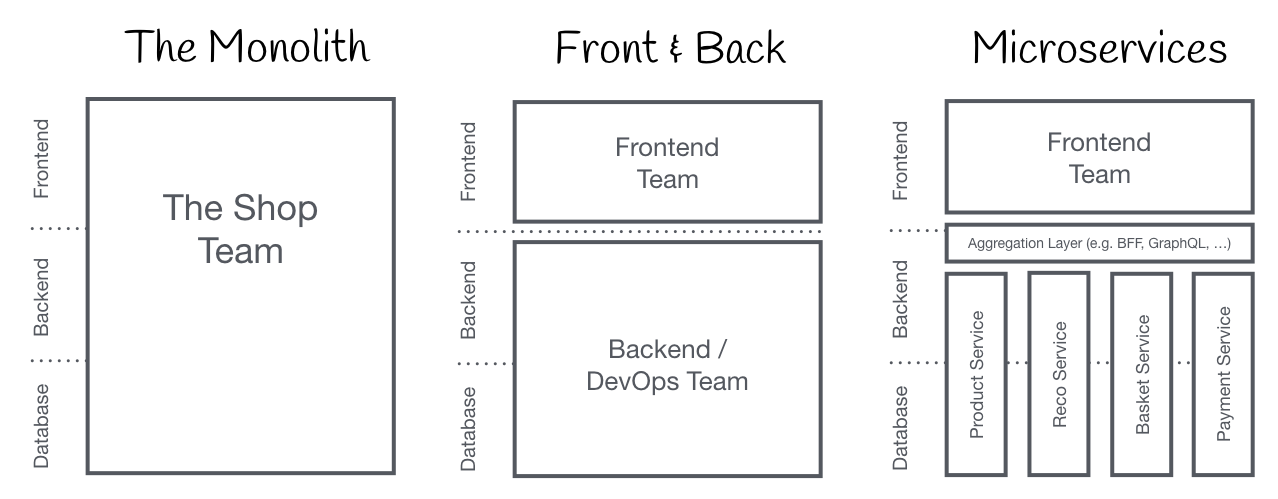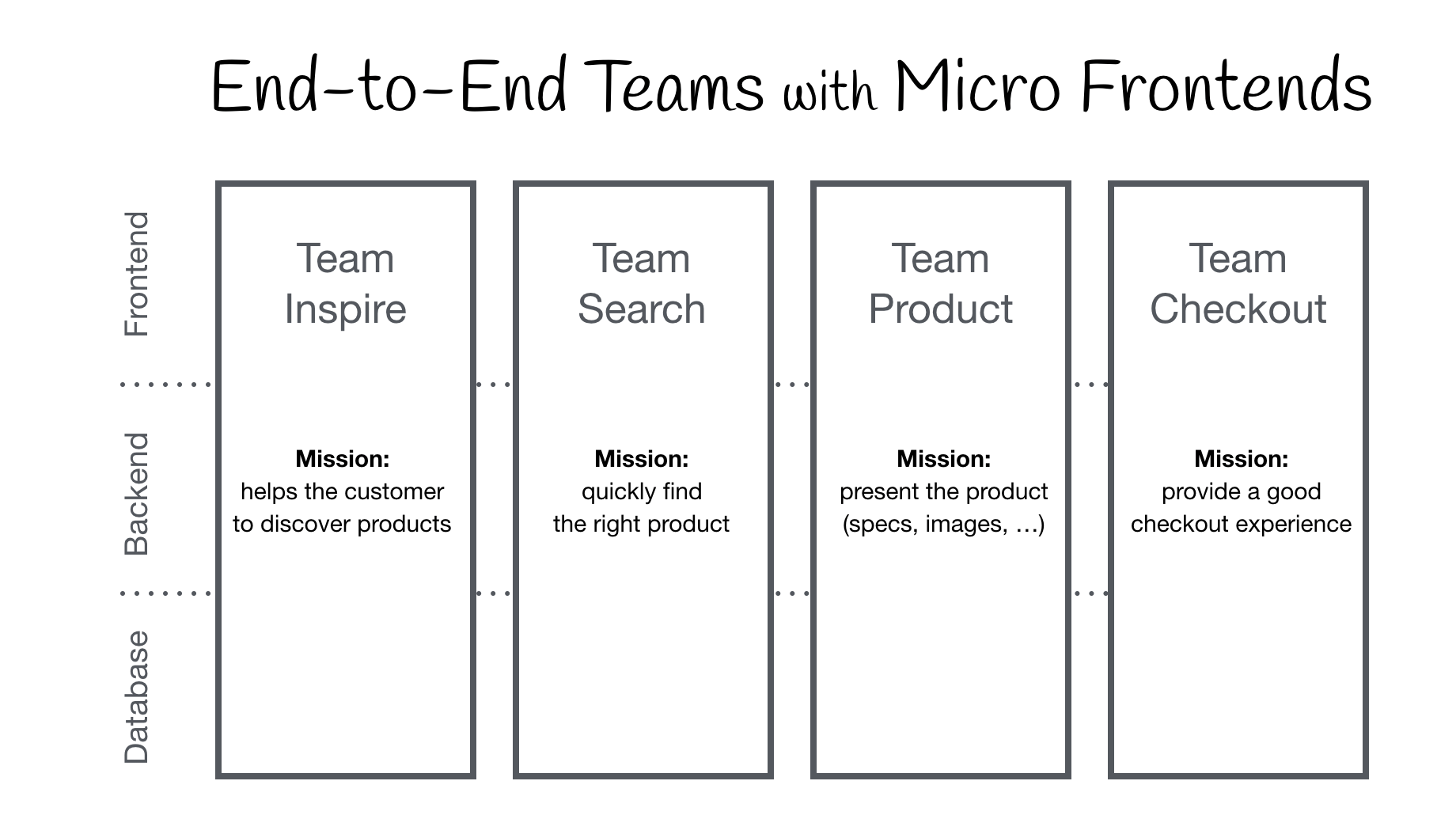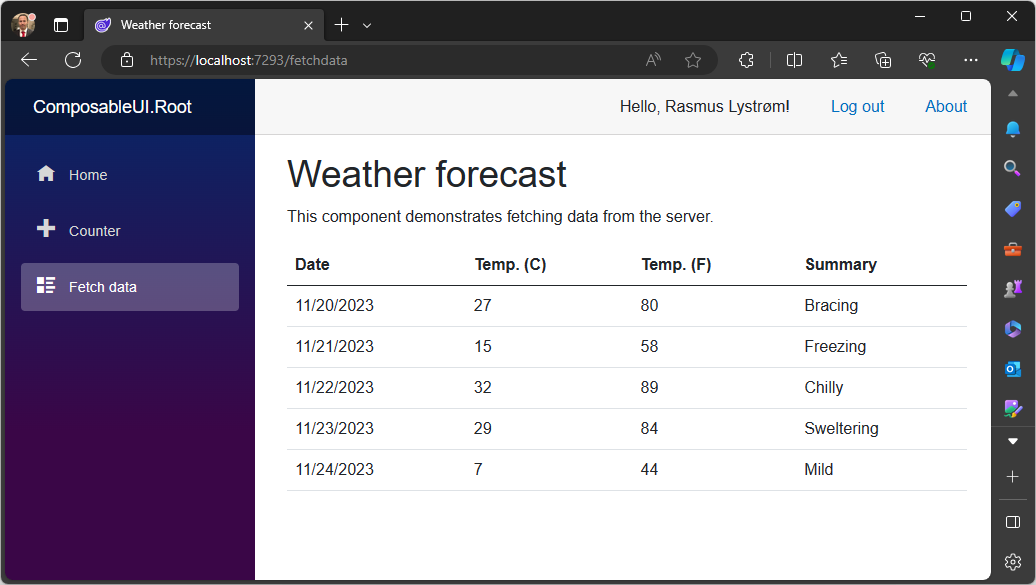Micro Frontends with Blazor WebAssembly
Recently one of my customers shared their challenges with sharing a large Blazor WebAssembly app between multiple teams.
The problem
Basically, as with all kinds of monoliths, the monolithic frontend makes for a huge pain in merge conflicts and the like when multiple teams are trying to add features to the same code base.
Conceptually this can be illustrated like this:
 Monolithic Frontends, source: Micro Frontends
Monolithic Frontends, source: Micro Frontends
A solution
Conceptually we want to take the concept of end-to-end responsibility into the frontend by organizing into verticals as illustrated here:
 Organisation in Verticals, source: Micro Frontends
Organisation in Verticals, source: Micro Frontends
The Blazor Proof of Concept
While the Micro Frontends make an excellent case for technology agnosticism the solution asked for centers around Blazor.
For simplicity the solution is built using only standard components where a little duplication of code is allowed for readability (#dry-is-over-rated) - i.e. there are no wonky build tasks like obscure copying of files and no use of reflection etc.
The PoC contains four repositories/solutions:
- Downstream API: Downstream API component
- Component 1: Example component (Counter)
- Component 2: Example component (Fetch data from downstream API)
- Root: A composable root
Downstream API
Vanilla ASP.NET Core Minimal APIs solution configured with Microsoft Entra ID authentication.
Component 1 and Component 2
Two components built with Razor class library (RCL).
For each component all logic is contained in the RCL. A Blazor client app is supplied with it, which allows the component to be run and developed individually.
Each component is built and pushed to GitHub Packages.
For local testing a Client app is supplied.
Root
This is the actual app. It contains as little code as possible.
This is a standard Blazor WebAssembly app which has been extended to use Component 1 and Component 2.
Technical implementation
The Root contains technical details worth noting:
Package handling
Add nuget.config to allow pulling packages from GitHub Packages.
<?xml version="1.0" encoding="utf-8"?>
<configuration>
<packageSources>
<clear />
<add key="nuget" value="https://api.nuget.org/v3/index.json" />
<add key="github" value="https://nuget.pkg.github.com/NAMESPACE/index.json" />
</packageSources>
<packageSourceCredentials>
<github>
<add key="Username" value="USERNAME" />
<add key="ClearTextPassword" value="TOKEN" />
</github>
</packageSourceCredentials>
</configuration>
Add the Component 1 and Component 2 packages to Root:
dotnet add package ComposableUI.Component1
dotnet add package ComposableUI.Component2
Authentication
Helpers:
public class DownstreamApiAuthorizationMessageHandler : AuthorizationMessageHandler
{
public DownstreamApiAuthorizationMessageHandler(IAccessTokenProvider provider,
NavigationManager navigation, IConfiguration config)
: base(provider, navigation)
{
ConfigureHandler(
authorizedUrls: [ config.GetSection("DownstreamApi")["BaseUrl"]! ],
scopes: config.GetSection("DownstreamApi:Scopes").Get<List<string>>());
}
}
public class DownstreamApiConfiguration
{
public required Uri BaseUrl { get; init; }
public required string[] Scopes { get; init; }
}
Modify Program.cs:
var downstreamApi = builder.Configuration.GetSection("DownstreamApi").Get<DownstreamApiConfiguration>() ?? throw new InvalidOperationException("DownstreamApi configuration is missing");
builder.Services.AddScoped<DownstreamApiAuthorizationMessageHandler>();
builder.Services.AddHttpClient("ComposableUI.DownstreamApi", client => client.BaseAddress = downstreamApi.BaseUrl)
.AddHttpMessageHandler<DownstreamApiAuthorizationMessageHandler>();
// Supply HttpClient instances that include access tokens when making requests to the server project
builder.Services.AddScoped(sp => sp.GetRequiredService<IHttpClientFactory>().CreateClient("ComposableUI.DownstreamApi"));
builder.Services.AddMsalAuthentication(options =>
{
builder.Configuration.Bind("AzureAd", options.ProviderOptions.Authentication);
foreach (var scope in downstreamApi.Scopes)
{
options.ProviderOptions.DefaultAccessTokenScopes.Add(scope);
}
});
Navigation and Routing
Add pages from Component 1 and Component 2 to NavMenu.razor:
<div class="nav-item px-3">
<NavLink class="nav-link" href="counter">
<span class="oi oi-plus" aria-hidden="true"></span> Counter
</NavLink>
</div>
<div class="nav-item px-3">
<NavLink class="nav-link" href="fetchdata">
<span class="oi oi-list-rich" aria-hidden="true"></span> Fetch data
</NavLink>
</div>
Configure App.razor to check additional assemblies for routes (pages):
<CascadingAuthenticationState>
<Router AppAssembly="@typeof(App).Assembly" AdditionalAssemblies="[ typeof(ComposableUI.Component1.Root).Assembly, typeof(ComposableUI.Component2.Root).Assembly ]">
...
</Router>
</CascadingAuthenticationState>
Conclusion
I believe this concept can solve a number of issues with having multiple teams contributing to the same frontend, however, some changes are required in the Root from time to time:
- When adding a new component
- When adding a new page to navigation
Feel free to grab what you need from GitHub.
Happy coding!
 Composable Root running locally
Composable Root running locally